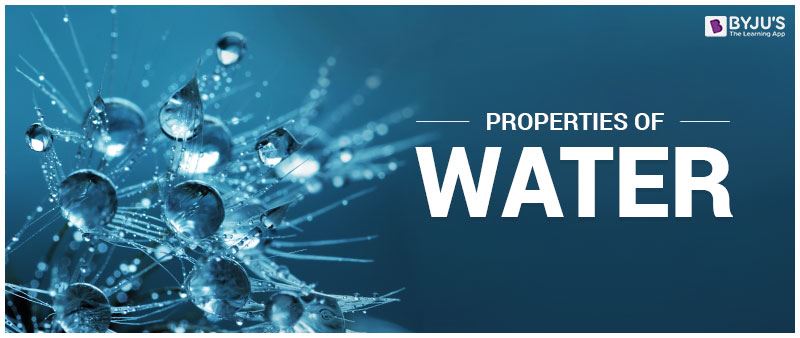What is water?
Water is the chemical substance with chemical formula H2O, one molecule of water has two hydrogen atoms covalently bonded to a single oxygen atom. Let us learn about the physical and chemical properties of water.
Table of Content
- Properties of Water
- Physical properties of water
- Chemical properties of water
- Frequently Asked Questions – FAQs
Properties of Water
A glance of earth taken from space will depict it blue. This blue colour is actually water, the major part of the earth is covered with water. We need water for almost everything, for example- drinking, bathing, cooking etc and therefore we should know about the properties of water. 65 % human body is composed of water. Water is essential for the survival of life on earth. Water is distributed unevenly on the earth’s surface. It forms a major solvent and dissolves almost every polar solute. So, let us have a look at its properties and understand the reason for its significance:
Physical properties of water
Water is a colourless and tasteless liquid. The molecules of water have extensive hydrogen bonds resulting in unusual properties in the condensed form. This also leads to high melting and boiling points. As compared to other liquids, water has a higher specific heat, thermal conductivity, surface tension, dipole moment, etc. These properties form the reason for its significance in the biosphere. Water is an excellent solvent and therefore it helps in the transportation of ions and molecules required for metabolism. It has a high latent heat of vaporization which helps in the regulation of body temperature.
Chemical properties of water
Water reacts with a lot of substances to form different compounds. Some significant reactions are as follows:
1. Amphoteric nature:
Water can act as both acid and base, which means that it is amphoteric in nature.
Example:
Acidic Behaviour:
Basic Behavior:
2. Redox reactions:
Electropositive elements reduce water to hydrogen molecule. Thus, water is a great source of hydrogen. Let us see an example in this case:
During the process of photosynthesis, water is oxidized to O2. As water can be oxidized and reduced, it is very useful in redox reactions.
3. Hydrolysis reaction
Water has a very strong hydrating tendency due to its dielectric constant. It dissolves many ionic compounds. Some covalent and ionic compounds can be hydrolyzed in water.
| Properties | |||||||||||||||||||||||||||||||||||||||||||||||||||||||||||
|---|---|---|---|---|---|---|---|---|---|---|---|---|---|---|---|---|---|---|---|---|---|---|---|---|---|---|---|---|---|---|---|---|---|---|---|---|---|---|---|---|---|---|---|---|---|---|---|---|---|---|---|---|---|---|---|---|---|---|---|
| Chemical formula | H2O | ||||||||||||||||||||||||||||||||||||||||||||||||||||||||||
| Molar mass | 18.01528(33) g/mol | ||||||||||||||||||||||||||||||||||||||||||||||||||||||||||
| Odour | None | ||||||||||||||||||||||||||||||||||||||||||||||||||||||||||
| Density | Solid:
0.9167 g/ml at 0 °C Liquid: 0.961893 g/mL at 95 °C 0.9970474 g/mL at 25 °C 0.9998396 g/mL at 0 °C |
||||||||||||||||||||||||||||||||||||||||||||||||||||||||||
| Boiling point | 99.98 °C (211.96 °F; 373.13 K) | ||||||||||||||||||||||||||||||||||||||||||||||||||||||||||
| Melting point | 0.00 °C (32.00 °F; 273.15 K) | ||||||||||||||||||||||||||||||||||||||||||||||||||||||||||
|
Solubility |
Poorly soluble in aliphatic and aromatic hydrocarbons, and Ethers. |
||||||||||||||||||||||||||||||||||||||||||||||||||||||||||
| Acidity (pKa)
|
13.995 | ||||||||||||||||||||||||||||||||||||||||||||||||||||||||||
| Vapour pressure | 3.1690 kilopascals or 0.031276 atm | ||||||||||||||||||||||||||||||||||||||||||||||||||||||||||
| Basicity (pKb) | 13.995 | ||||||||||||||||||||||||||||||||||||||||||||||||||||||||||
| Refractive index(nD) | 1.3330 (20°C) | ||||||||||||||||||||||||||||||||||||||||||||||||||||||||||
| Thermal conductivity | 0.6065 W/m·K | ||||||||||||||||||||||||||||||||||||||||||||||||||||||||||
| Viscosity | 0.890 cP | ||||||||||||||||||||||||||||||||||||||||||||||||||||||||||
| Structure | |||||||||||||||||||||||||||||||||||||||||||||||||||||||||||
| Crystal structure | Hexagonal | ||||||||||||||||||||||||||||||||||||||||||||||||||||||||||
| Molecular shape | Bent | ||||||||||||||||||||||||||||||||||||||||||||||||||||||||||
| Point group | C2v | ||||||||||||||||||||||||||||||||||||||||||||||||||||||||||
| Dipole moment | 1.8546 D | ||||||||||||||||||||||||||||||||||||||||||||||||||||||||||
| Thermochemistry | |||||||||||||||||||||||||||||||||||||||||||||||||||||||||||
| Specific heat capacity (C) | 75.375 ± 0.05 J/mol·K | ||||||||||||||||||||||||||||||||||||||||||||||||||||||||||
| Std enthalpy of formation (ΔfHo298) | -285.83 ± 0.040 kJ/mol | ||||||||||||||||||||||||||||||||||||||||||||||||||||||||||
| Std molar entropy (So298) | 69.95 ± 0.03 J/mol·K | ||||||||||||||||||||||||||||||||||||||||||||||||||||||||||
| Gibbs free energy(ΔfG˚) | -237.24 kJ/mol | ||||||||||||||||||||||||||||||||||||||||||||||||||||||||||
Frequently Asked Questions – FAQs
What is the melting point?
The temperature at which a solid becomes a liquid due to enough heat. For a given substance, its solid form’s melting point is the same as its liquid form’s freezing point and depends on factors such as the substance’s purity and surrounding pressure.
How does boiling point work?
A liquid‘s boiling point is the temperature at which its vapor pressure is equal to that of the atmospheric pressure. The normal boiling point of a liquid is the temperature at which one atmosphere (760 torr) is equal to its vapor pressure. The normal boiling point of water is 100 degree celcius.
What affects the boiling point of water?
The surrounding pressures are the greatest determinant of the boiling point of a liquid. The air pressure in an open system is most definitely the atmosphere on earth. For instance, water reaches the standard atmospheric pressure at 100 degrees centigrade. Water can boil at a lower temperature as elevation increases.
What is specific heat in chemistry?
The amount of energy needed to increase the temperature of 1 gram of a material by 1 °C is known as its specific heat.
Why is specific heat important?
Water’s high specific heat capacity makes it suitable for central heating systems because it can transfer a lot of energy by heating while its temperature changes just slightly.
We have seen the physical and chemical properties of water and understood its importance. There is a lot more to explore and learn about water. If you are curious to know further, kindly install BYJU’S – The Learning App.


This information was very effective for my knowledge and work given. Thank you.
Thanks a lot! This information is amazing to keep up with our school work. It’s short and simple and very effective for students studying high-time!